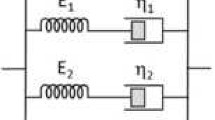Abstract
The Poisson's ratio of a material is strictly defined only for small strain linear elastic behavior. In practice, engineering strains are often used to calculate Poisson's ratio in place of the mathematically correct true strains with only very small differences resulting in the case of many engineering amterials. The engineering strain definition is often used even in the inelastic region, for example, in metals during plastic yielding. However, for highly nonlinear elastic materials, such as many biomaterials, smart materials and microstructured materials, this convenient extension may be misleading, and it becomes advantageous to define a strainvarying Poisson's function. This is analogous to the use of a tangent modulus for stiffness. An important recent application of such a Poisson's function is that of auxetic materials that demonstrate a negative Poisson's ratio and are often highly strain dependent. In this paper, the importance of the use of a Poisson's function in appropriate circumstances is demonstrated. Interpretation methods for coping with error-sensitive data or small strains are also described.
Similar content being viewed by others
Abbreviations
- e :
-
engineering strain (also known as nominal or Cauchy)
- l 0 :
-
starting length
- l i :
-
length
- ε:
-
true strain (also known as Hencky strain)
- εint :
-
instantaneous true strain
- εlog :
-
log transform true strain
- εtot :
-
total instantaneous true strain
- ν:
-
Poisson's ratio or function
- νeng :
-
Poisson's ratio (engineering strain)
- νint :
-
Poisson's ratio (instantaneous true strain)
- νlog :
-
Poisson's ratio (log transform true strain)
- νtot :
-
Poisson's function (total instantaneous true strain)
References
Caddock, B.D. andEvans, K.E., “Microporous Materials with Negative Poisson's Ratios. I: Microstructure and Mechanical Properties,”J. Phys. D. Appl. Phys.,22,1877–1882 (1989).
Friis, E.A., Lakes, R.S., andPark, J.B., “Negative Poisson's Ratio Polymeric and Metallic Foams,”J. Mat. Sci.,23,4406–4414 (1988).
Lakes, R.S., “Foam Structures with Negative Poisson's Ratio,”Science,235,1038–1040 (1987).
Lakes, R.S., “Advances in Negative Poisson's Ratio Materials,”Adv. Mat.,5,293–296 (1993).
Neale, P.J., Alderson, K.L., Pickles, A.P., andEvans, K.E., “Negative Poisson's Ratio of Microporous Polyethylene in Compression,”J. Mat. Sci. Lett.,12,1529–1532 (1993).
Pickles, A.P., Alderson, K.L., andEvans, K.E., “The Effects of Powder Morphology on the Processing of Auxetic Polypropylene,”Polymer Eng. Sci.,36,636–642 (1996).
Fortes, M.A. andNogueria, M.T., “The Poisson Effect in Cork,”Mat. Sci. Eng.,A122,227–232 (1989).
Lees, C., Vincent, J.F.V., andHillerton, J.E., “Poisson's Ratio in Skin,”Biomed. Mat. Eng.,1,19–23 (1991).
Vermda, D.R. andWertman, R.A., “Mechanical Characteristics of Skin—Finite Deformation,”J. Biomech.,3,111–124 (1970).
Evans, K.E., “Tailoring the Negative Poisson's Ratio,”Chem. Ind.,20,654–657 (1990).
Evans, K.E., “Auxetic Polymers: A New Range of Materials,”Endeavour,15,170–174 (1994).
Alderson, K.L., Pickles, A.P., Neale, P.J., andEvans, K.E., “Auxetic Polyethylene: The Effect of a Negative Poisson's Ratio on Hardness,”Acta Metall. Mat.,42,2261–2266 (1994).
Alderson, K.L., Alderson, A., andEvans, K.E., “The Interpretation of the Strain-dependent Poisson's Ratio in Auxetic Polyethylene,”J. Strain Anal.,32,201–212 (1997).
Alderson, A. andEvans, K.E., “Modelling Concurrent Deformation Mechanisms in Auxetic Microporous Polymers,”J. Mat. Sci.,37,1–13 (1997).
Evans, K.E., “Tensile Network Microstructures Exhibiting Negative Poisson's Ratios,”J. Phys. D. Appl. Phys.,22,1870–1876 (1989).
Evans, K.E. andCaddock, B.D., “Microporous Materials with Negative Poisson's Ratios. 2: Mechanisms and Interpretation,”J. Phys. D. Appl. Phys.,22,1883–1887 (1989).
Evans, K.E., Nkansah, M.A., Hutchinson, I.J., andRogers, S.C., “Molecular Network Design,”Nature,353,124 (1991).
Beatty, M.F. andStalnaker, D.O., “The Poisson Function of Finite Elasticity,”J. Appl. Mech.,53,807–813 (1986).
Prall, D. andLakes, R.S., “Properties of a Chiral Honeycomb with a Poisson's Ratio of — 1,”Int. J. Mech. Sci.,39,305–314 (1997).
Rinde, J.A., “Poisson's Ratio for Rigid Plastic Foams,”J. Appl. Polymer Sci.,14,1913–1926 (1970).
Gere, J.M. andTimoshenko, S.P., Mechanics of Materials, Chapman and Hall, London (1991).
Hilderbrand, F.B., Introduction to Numerical Analysis, McGraw-Hill, London (1956).
Rabiner, L.R. andGold, B., Theory and Application of Digital Signal Processing, Prentice Hall, London (1975).
Author information
Authors and Affiliations
Rights and permissions
About this article
Cite this article
Smith, C.W., Wootton, R.J. & Evans, K.E. Interpretation of experimental data for Poisson's ratio of highly nonlinear materials. Exp Mech 39, 356–362 (1999). https://doi.org/10.1007/BF02329817
Received:
Revised:
Issue Date:
DOI: https://doi.org/10.1007/BF02329817




